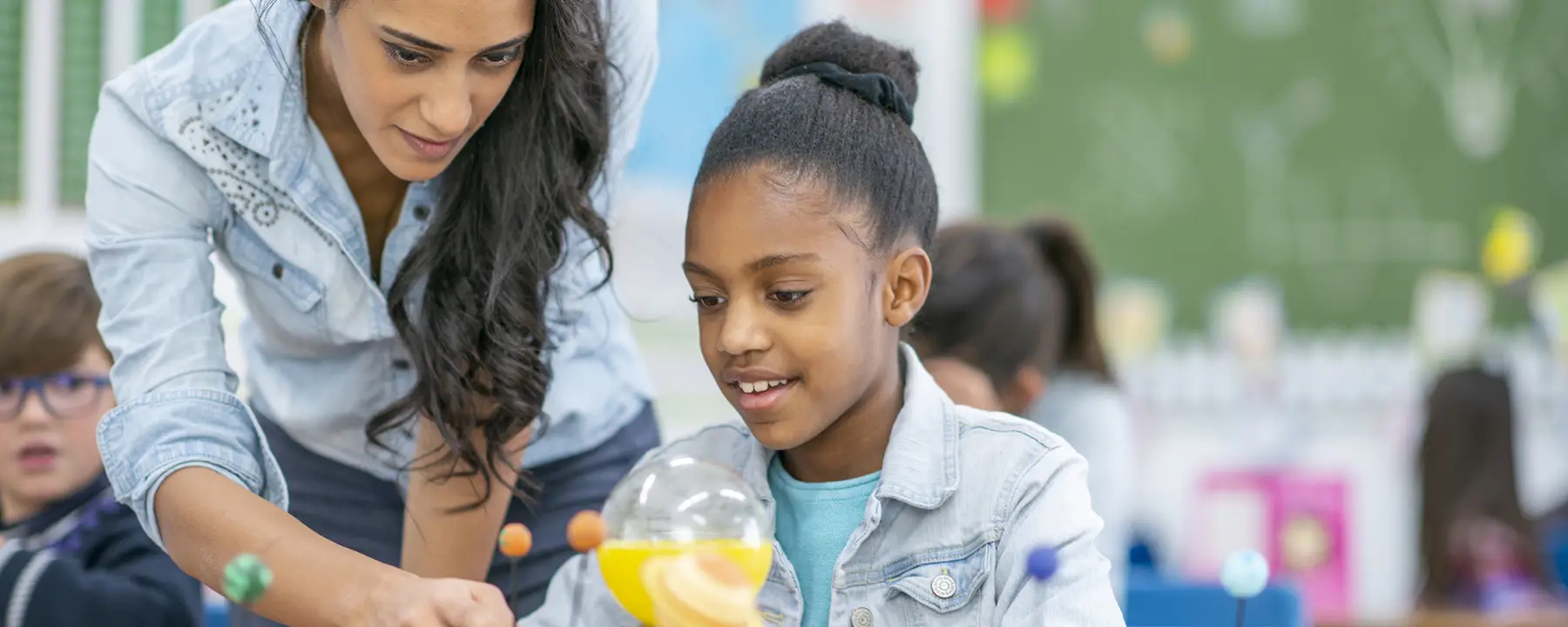Using the wonder of space to inspire students and to reinforce the implementation of project-based learning in the classroom
Objective
To address the needs of the growing STEM workforce by providing access to STEM education to students in Cumberland County, North Carolina.
Approach
The program uses project-based learning (PBL) and space to ignite student interest in STEM careers.
Impact
STARward STEM improves teachers' capabilities and increases student engagement in STEM learning.
The U.S. Bureau of Labor Statistics says science, technology, engineering, and mathematics (STEM) careers are expected to grow exponentially over the next decade – twice as fast as all other occupations combined. So what does that mean for educators? To keep up with the future demand for STEM leaders in the workforce, teaching and learning in K-12 schools needs to focus on preparing students with knowledge and skills that are essential for these careers. Project-based learning (PBL) has been shown to be an effective strategy to do just this with an approach to instruction that inspires curiosity, creates opportunities for problem-solving, and challenges misconceptions of what a career in science or mathematics could really look like. This approach is more important than ever in preparing students for a demanding future.
That’s where RTI International and the STARward STEM program come in. STARward STEM brings PBL to classrooms with a focus on Space, a priority of DoD Research and Engineering, with the goal to provide America’s future STEM leaders with enriched educational opportunities to lead in modernization, discovery, and technological innovation. With funding provided by DoD STEM, RTI, Cumberland County Schools (CCS), DreamUp, the Emerging Technology Institute (ETI), and the U.S. Space and Rocket Center have partnered to engage teachers and students in PBL in the classroom in ways that extend student learning far beyond classroom walls.
Creating Inquiring Minds
PBL and inquiry-based learning are not new approaches to teaching and learning. However, integrating these approaches into traditional education settings has been an ongoing challenge for educators. The STARward STEM program is a collaborative effort between RTI, the U.S. Department of Defense (DoD), and Cumberland County Schools (CCS) that was developed to tackle this challenge. The program has been designed to impact a targeted subset of more than 4,600 K-12 students and 300 educators in CCS, North Carolina’s fifth largest school district. CCS also serves one of the highest populations of military-connected students in the southeast.
STARward STEM focuses on promoting deliberate access to STEM education by providing students and teachers with “STAR” experiences: Something They’ll Always Remember. These experiences include powerful PBL in the classroom that connects students to exploration of real-world challenges. It also involves additional STEM enrichment including school-based STEM night programming for students and families and connecting students and teachers with STEM experts to learn more about STEM careers. RTI, CCS, and other partners are working together to implement the program over a three year period – developing a STEM-focused pipeline in eight elementary schools, two middle schools and one high school in the district, with the goal to expand the program to other schools in the future.
The program aims to answer a few of the most pressing questions facing educators working to address STEM competencies through authentic and PBL applications:
“How can we create sustainable change that supports innovative instruction in the classroom?”
“How do we build excitement among students at every grade level?”
“What do our students need to be better prepared for their careers and life?”
The STARward program draws on research and what partners have indicated employers really need from their future workforce. It is also focused on objectives identified in the federal STEM plan and DoD modernization priorities. Based on these reference points, STARward STEM focuses on PBL and Space to provide the inspiration to ignite student interest in STEM careers while also building key competencies as lifelong learners.
Making Space for New Ideas
The regions beyond Earth’s atmosphere stir fascination and curiosity across every age. From elementary students discovering the Milky Way, to leaders in business creating opportunities for commercial space exploration, the final frontier inspires discovery. The STARward STEM program is harnessing this inspiration to propel student learning forward.
Space education is a modernization priority for the DoD, and CCS’ community of military-connected families serves as the perfect community for RTI to work as the catalyst for a new approach to inquiry-based learning. Throughout the program, students and teachers have opportunities to participate in experiments with outside partners, like DreamUp, engage with STEM career professionals, and work with RTI to engage in ongoing professional development in PBL and STEM integration strategies.
The program culminates each year in a design challenge where three winning student projects are flown to the International Space Station for experimentation as payload aboard a scheduled rocket launch. The approach aims to balance the wonder of cutting-edge scientific discovery with real-world applications that ignite students’ critical thinking and problem-solving skills.
Evaluating the Impact of STEM PBL in Classrooms
Our initial evaluation shows that STARward STEM improved teachers’ capacity to implement STEM PBL in their classrooms and increased students’ engagement in STEM.
The evaluation found that teachers doubled the number of PBL activities they implemented with their students compared to the prior year, while that number was tripled for STEM-focused PBL learning activities. Further, teachers cited how helpful STEM and PBL professional development and job-embedded instructional coaching were to increase their STEM knowledge and improve their instruction.
STARward STEM successfully engaged more than 1,280 students in PBL and STEM enrichment activities during the 2021-2022 school year. We found that these students were more likely to engage in STEM and PBL learning activities as a result of the program. These activities included:
- Developing and testing new ideas and theories
- Managing their own project work
- Engaging in critical thinking
- Reflecting on project work
- Refining their work based on feedback from peers and teachers
- Demonstrating their understanding of concepts to audiences beyond their immediate classroom
One student comment speaks to the power that PBL and related STARward STEM activities have to change perspectives:
I liked the projects that we did. There has been a lot of communication and I have been able to teach other people what I have learned. Learning more about STEM is starting to change my perspective of the world.
Participating teachers in CCS are excited about the opportunity for students to engage in future-focused experiences, and the opportunity to increase their understanding of PBL and inquiry-based teaching methods as the program moves forward. Angela Adams, K-5 Science Curriculum Specialist for CCS, is enthusiastic about how STARward STEM can help teachers engage students, build interest in STEM, and better prepare them for the future. Adams describes the program as “out of this world,” adding that “Having this opportunity is an outstanding experience for our teachers and students – it’s a great way to explore the practices used by NASA and its providing students with the skills they need to solve real-world problems.”
Watch How the Program Inspires Future STEM Professionals
Download Our Free On Demand Webinar
Interested in learning more about how to successfully increase STEM participation? Download our free on demand webinar.

